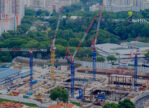Impact of COVID-19 Second Wave Delayed the Revival of Commercial Real Estate

The COVID-19 pandemic has been deeply disruptive to real estate markets around the world. The initial stages of the virus from April/May 2020 onwards saw steep declines in demand, revenue and development across the board. Furthermore, commercial sectors were among the most severely hit due to the change in work practices during the pandemic. The 2nd wave of COVID has seen a significant spike in infections which has caused many industries to slow down again after the brief improvement of late 2020 and early 2021. Here, we compiled data about the 2nd wave of COVID and its effects on commercial real estate.
The pandemic restrictions
The 2nd wave of COVID-19, which began in early March 2021, has been the cause of great economic decline throughout the nation. Citywide lockdowns in major metropolitan hubs like Mumbai, New Delhi, and Bangalore, along with strictly enforced curfews have been implemented to stop the spread of the virus.
Naturally, such steps have hindered demand for commercial real estate as people cannot engage in normal work or leisure related activities outside their homes. These restrictions have also slowed down ongoing construction, with a lot of the work having to be handled off-site. Perhaps understandably, potential real estate investors are choosing to wait and watch how the market progresses in the coming weeks before purchasing any properties. All in all, the 2nd wave has slowed down commercial real estate growth substantially.
The decline
According to JLL, the commercial real estate market has seen a decline in net absorption by 37% in Q1 2021. As per the study, only 2 major cities in the country, New Delhi and Bangalore showed a marginal increase in the market, with other cities reporting declines in the leasing of up to 33%. The reason for this has been generally agreed to be pre-commitments in newly completed projects.
Commercial space vacancy is on the rise as well, with the current estimates showing a 14.9% vacancy as compared to 14% in Q$ 2020 and 12.8% in March of 2020. This is not a good trend for a market that has been showing growth potential for years. Furthermore, the commercial real estate industry was hoping for a revival in 2021 to make up for the losses of 2020, which for now seems rather unlikely.
The revival
In spite of the currently unfavourable situation, there are certain positive indications that might hint at a come-back for the real estate market in the future:
Vaccination- Perhaps the best news in recent weeks for all economic sectors of the country has been the authorisation of vaccine inoculation for 18-45yr olds. Naturally, this bodes well for commercial real estate as well. With widespread vaccination, there should be a gradual but steady increase in demand from both companies looking for workspaces and clients looking for services.
A number of vaccine drives have already taken place in most urban-based companies. E.g. Greenscape Navi Mumbai, Exide Kolkata, and all major national corporates across states.
Pre 2nd wave growth- The steady influx of on-site workers from December 2020 to February 2021 indicate that there is still a workforce willing to utilise commercial real estate, with IT fields being the most prominent investors in such spaces. This may well hold true after the 2nd wave finishes, hopefully leading to a strong increase in demand for this market.
Better preparation- Most corporates of the country, including the real estate companies, are much better prepared to handle a COVID wave than they were in early 2020. With safety being given top priority, a lot of the work has been swiftly moved online and work from home is being encouraged. These steps plus the vaccination is expected to help limit the spread of the virus significantly which should lead to a quicker end to the pandemic.
Conclusion
While the 2nd wave of COVID-19 has been detrimental to the growth of commercial real estate, it is not expected to be the status quo for long. And there is every hope for a strong recovery of this market once the pandemic dies down.



